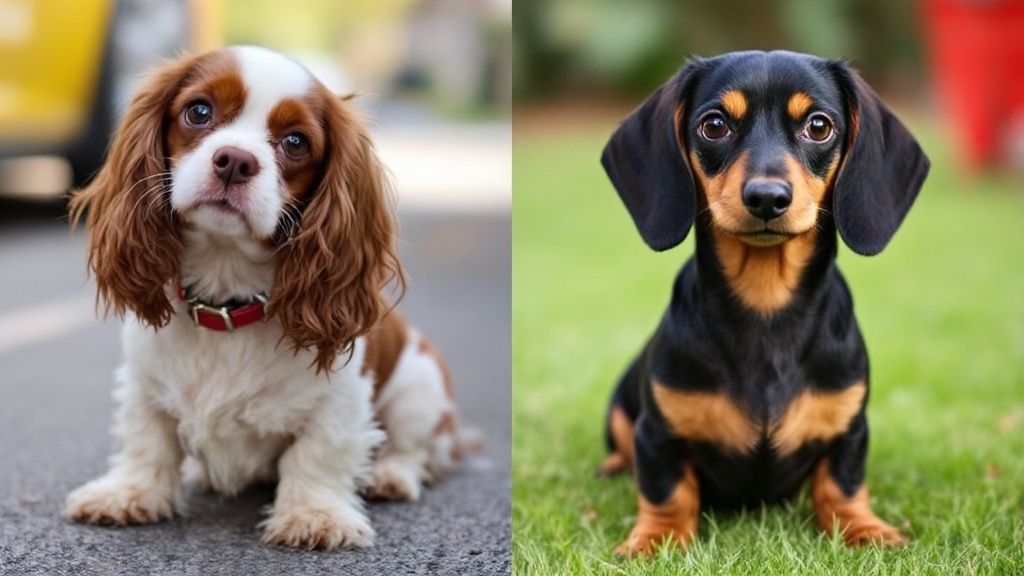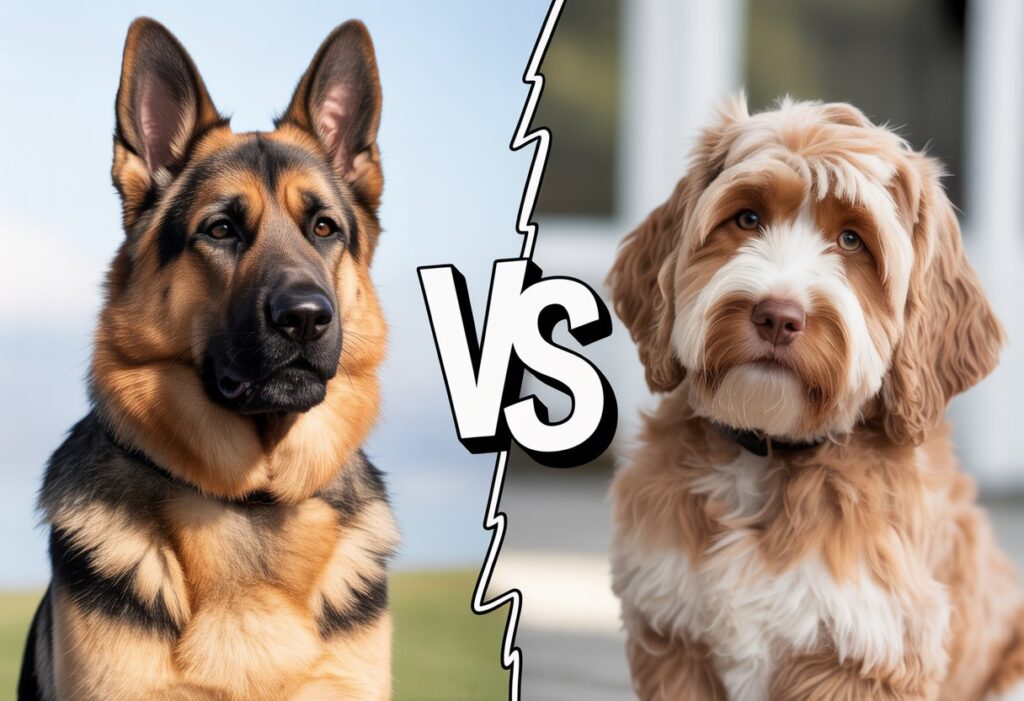If you’re torn between a Cavalier King Charles Spaniel and a Dachshund, you’re definitely not alone. Both breeds have a loyal following among families, singles, and even seniors, thanks to their small size and outgoing personalities.
They share a few things in common, but their differences in health, energy, and temperament can really change your day-to-day routine.
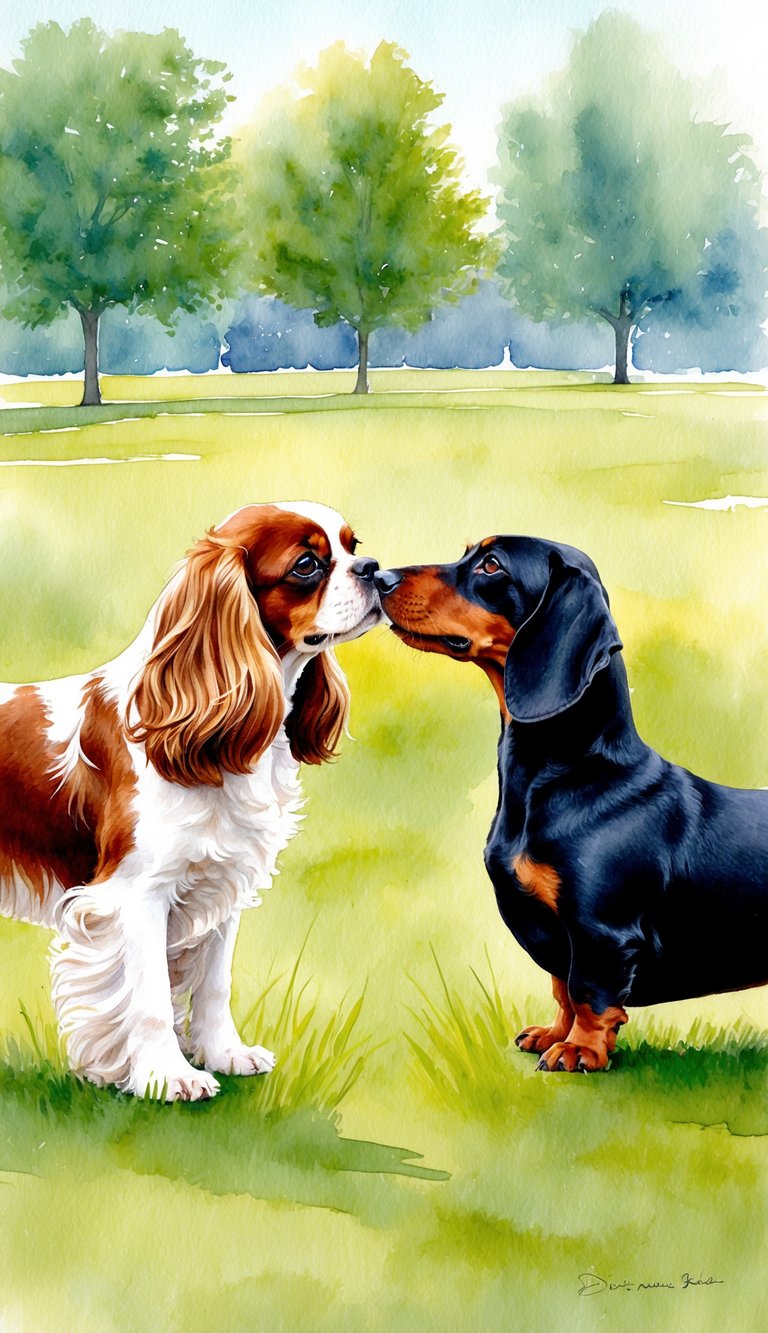
The main difference is that Cavaliers are gentle and affectionate, while Dachshunds tend to be bolder and more vocal. Cavaliers may rack up higher vet bills due to more health issues, while Dachshunds are usually hardy but can be stubborn.
Dachshunds are playful and loyal, though sometimes a bit headstrong.
Breed Origins and History
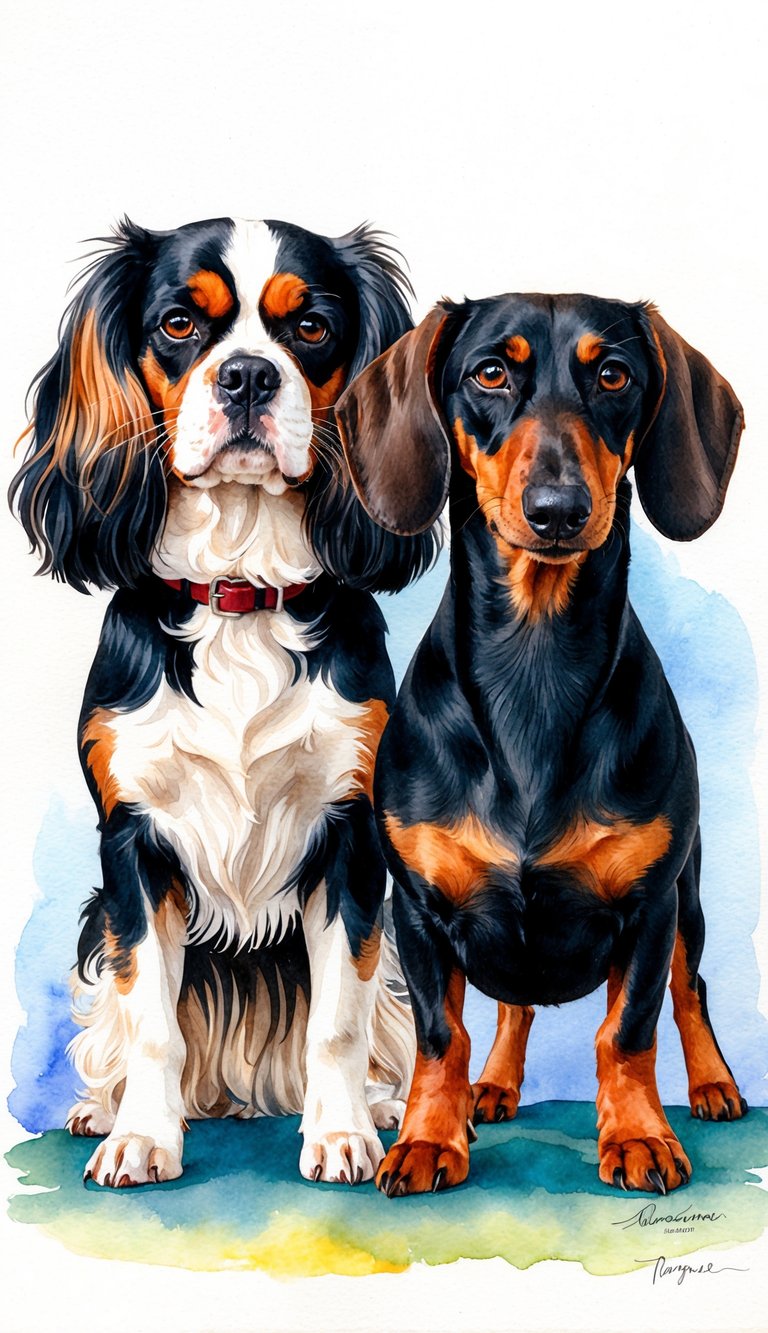
Both the Cavalier King Charles Spaniel and the Dachshund have their roots in Europe. Their backgrounds reveal a lot about their quirks and personalities, from royal courts to hunting fields.
Cavalier King Charles Spaniel Lineage
The Cavalier King Charles Spaniel is basically royalty in dog form. Toy spaniels became favorites of King Charles I and II in the 17th century.
They ended up in classic paintings and on the laps of nobles, pretty much living the good life.
Breeders aimed for a gentle temperament and a sweet look, picking for long ears, expressive eyes, and a soft coat. The breed almost faded away, but fans brought it back in the early 1900s, restoring the look we know today.
You can dive deeper into this in the Cavalier King Charles Spaniel vs Dachshund comparison.
Dachshund Development
Dachshunds hail from Germany and were bred to hunt badgers. The name literally means “badger dog” in German.
Early breeders wanted a long, low dog that could dig and chase prey underground.
Dachshunds have strong legs and deep chests, making them perfect for tunneling and hunting. By the 1800s, people also bred them for tracking wounded animals, which led to both smooth and long-haired versions.
Modern Dachshunds still show off those working-dog traits.
Evolution of Breeding Practices
Early breeding was all about skills or looks, nothing else. Over time, breeders started picking for health and personality too.
When royal courts wanted Cavaliers, breeders picked for softer faces and a calm attitude. Dachshund breeders focused on courage and physical traits for hunting.
These days, breeders keep better records and health screen their dogs to avoid genetic issues. That’s helped both breeds dodge some inherited diseases.
For more, check out this comparison between the Cavalier King Charles Spaniel and Dachshund.
Physical Characteristics
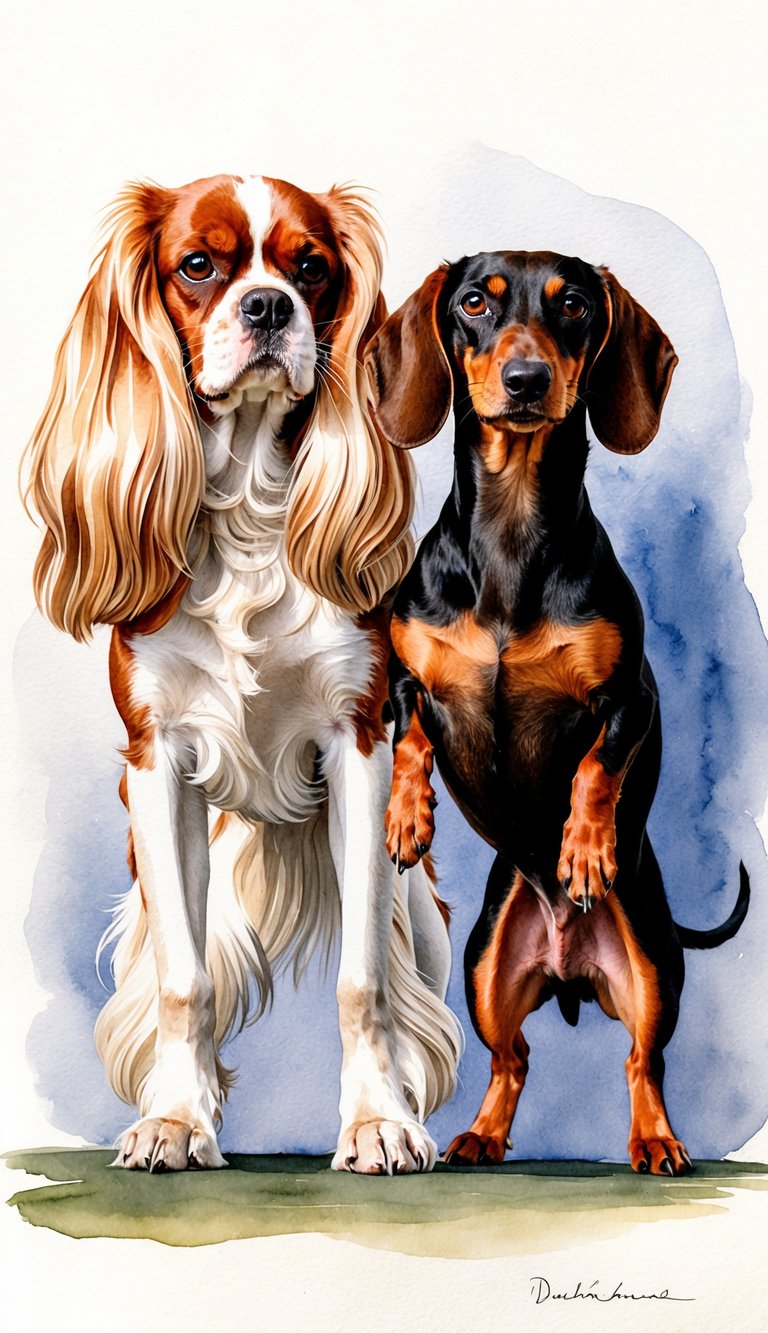
Cavalier King Charles Spaniels and Dachshunds look nothing alike. Their size, coats, and colors make each breed stand out.
Knowing these details can help you figure out which one fits your style and care routine.
Size and Weight Differences
Cavalier King Charles Spaniels are small dogs, usually weighing 13 to 18 pounds and standing about 12 to 13 inches tall. Dachshunds come in standard and miniature sizes.
Standard Dachshunds weigh 16 to 32 pounds, while miniatures are under 11 pounds. Dachshunds are shorter, usually 8 to 9 inches tall at the shoulder.
Spaniels have a sturdy but elegant build, while Dachshunds are famous for their long bodies and stubby legs. Cavaliers are born lap dogs, made for comfort and cuddles.
If you want a taller, classic-looking dog, the Cavalier might be your pick. Prefer a quirky shape or a truly small dog? A Dachshund could be your match.
Coat Colors and Types
Cavalier King Charles Spaniels have silky, medium-length coats that feather out at their ears, chest, legs, and tail. You’ll see them in four main colors: Blenheim (chestnut on white), ruby (solid red), black and tan, and tricolor.
Their coats feel soft and look pretty fancy.
Dachshunds have three coat types: smooth, long-haired, and wire-haired. Each feels different to the touch. Their colors range from red, black and tan, chocolate, wild boar, to dapple.
Dachshunds come in more coat styles and colors than Cavaliers. Grooming needs depend on the coat—a long-haired or wire-haired Dachshund will need more brushing than the short-haired ones.
General Appearance
Cavalier King Charles Spaniels have big, round eyes, long feathered ears, and a sweet, gentle face. Their bodies are graceful but not fragile, and they look like they belong in a portrait.
Dachshunds are long and low, with deep chests and front legs that turn out a bit. Their faces are alert, with long muzzles and oval eyes. They’re lively, and honestly, their shape is unforgettable.
If you’re drawn to gentle, classic looks, the Cavalier might win you over. If you want a dog with a bold, quirky silhouette, Dachshunds are hard to miss.
You can compare more breed details at Dog Learn’s full breed comparison chart.
Temperament and Personality
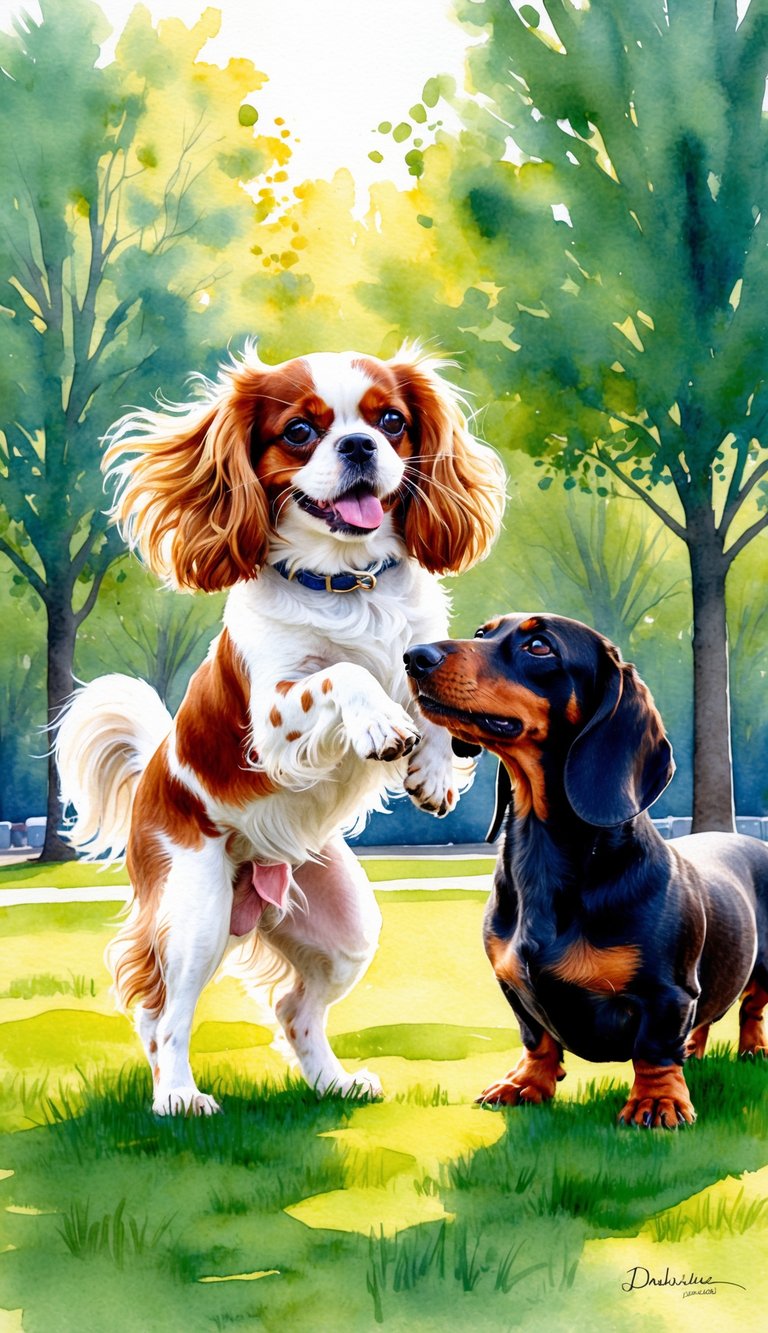
Cavalier King Charles Spaniels and Dachshunds both make great pets, but their personalities can be worlds apart. These differences affect everything from family life to how they get along with other pets.
Interaction with Families
Cavalier King Charles Spaniels are gentle and affectionate. They love being with their people and usually get along well with kids.
Most Cavaliers are quick to cuddle and don’t like being alone too much. They’re sensitive, so harsh words or yelling can upset them.
Dachshunds are friendly, but a bit more independent. They bond closely with their main humans and can be playful, but some act shy or cautious around strangers.
With young kids, it’s best to supervise, since some Dachshunds might snap if handled roughly.
If you want a dog that’s easy to bring into a family with kids, the Cavalier’s gentle nature is a plus. Dachshunds can fit in too, but patience and gentle handling go a long way.
Energy Levels and Behavior
Cavalier King Charles Spaniel
- Moderate energy, likes to play but enjoys relaxing too
- Happy with short walks and indoor games
Dachshund
- High energy in quick bursts, especially as puppies
- Loves to dig, chase things, and explore—so a secure yard is a must
Cavaliers are usually quiet and adapt well to calm homes. Dachshunds are a bit more vocal, barking at strangers or odd noises.
Both breeds need daily attention and some routine, or they’ll get bored.
Compatibility with Other Pets
If you have other pets, think about how these breeds fit in. Cavaliers are usually friendly with other dogs and cats.
Their easygoing attitude helps them settle into multi-pet homes.
Dachshunds can get along with other dogs, but their hunting instincts sometimes kick in—especially with small pets like rabbits or guinea pigs.
Slow introductions and supervision help. Early socializing makes a big difference.
Both breeds do best with positive guidance and some patience. For a deeper dive, check out this Cavalier King Charles Spaniel vs Dachshund guide.
Health Considerations
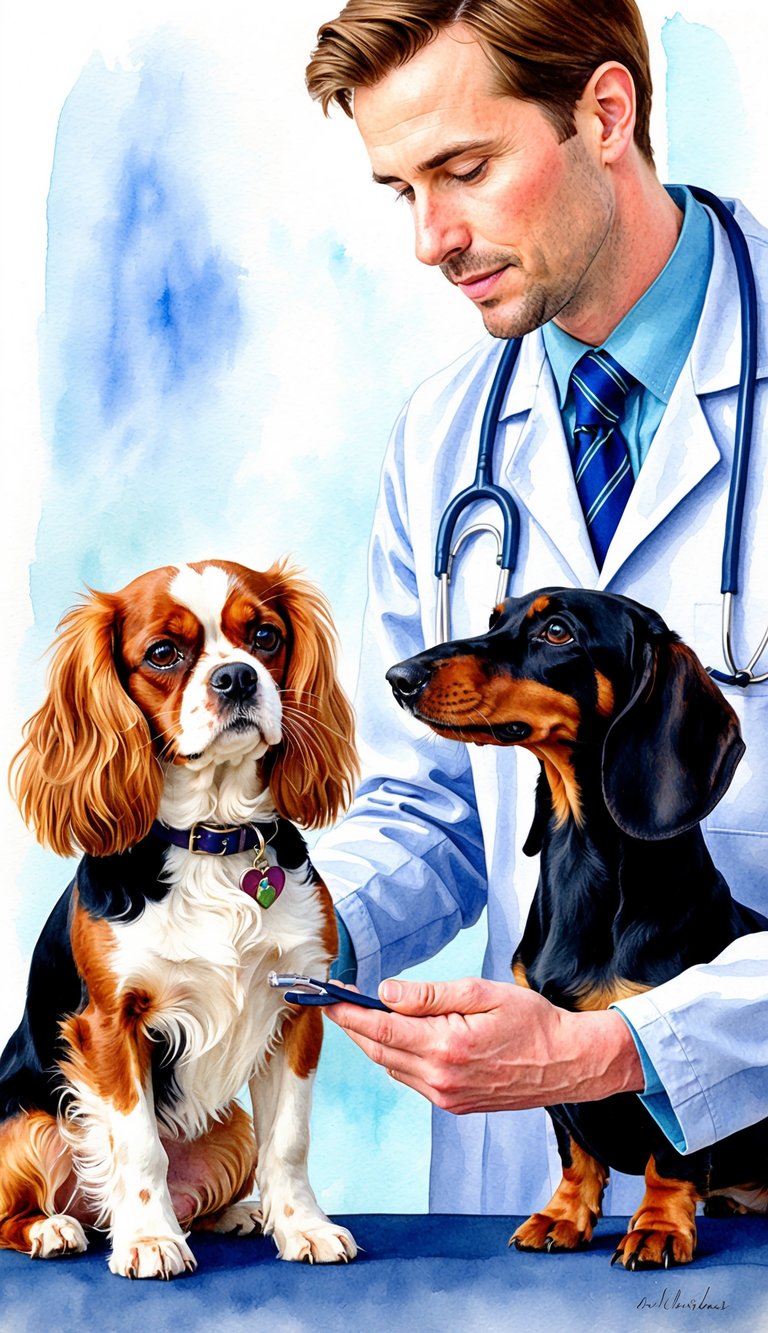
Cavalier King Charles Spaniels often deal with serious heart problems. Dachshunds, on the other hand, are more likely to face back issues.
It’s worth knowing about these health risks before making your choice.
Common Genetic Diseases
Both breeds can pass on health issues to their puppies. Cavaliers often struggle with syringomyelia, which is a painful spine and brain condition.
They’re also prone to eye diseases and loose kneecaps.
Dachshunds are at higher risk for intervertebral disc disease, thanks to their long backs. This can cause back pain or even paralysis.
Obesity makes it worse, so keeping them lean is important. Dachshunds can also have dental problems and progressive retinal atrophy.
Here’s a quick list of common genetic diseases:
- Cavalier King Charles Spaniel: Syringomyelia, eye disorders, luxating patella
- Dachshund: Intervertebral disc disease, dental problems, progressive retinal atrophy
For more on inherited health issues, check out Buddy Breeds.
Heart Health and Cardiac Issues
Heart health matters a lot, especially for Cavalier King Charles Spaniels. This breed often struggles with myxomatous mitral valve disease (MMVD), which affects the mitral valve between the heart’s chambers.
If MMVD isn’t managed, it can develop into congestive heart failure. About half of Cavaliers over five years old end up with this disease—pretty staggering, honestly.
Dachshunds don’t face as many heart problems, but any dog can start having cardiac issues as they get older. Genetic studies have found some harmful variants, like changes in the NEBL gene, that mess with heart muscle protein.
These genetic risks matter most for Cavaliers, since they’re more likely to inherit them. Annual heart checks and catching problems early can really help your Cavalier King Charles Spaniel.
If you’re thinking about this breed, just know you’ll be making regular trips to the vet and might need to manage medication long-term. There’s a detailed comparison of breed-specific heart health over at Dog Learn.
Breed-Specific Research and Studies
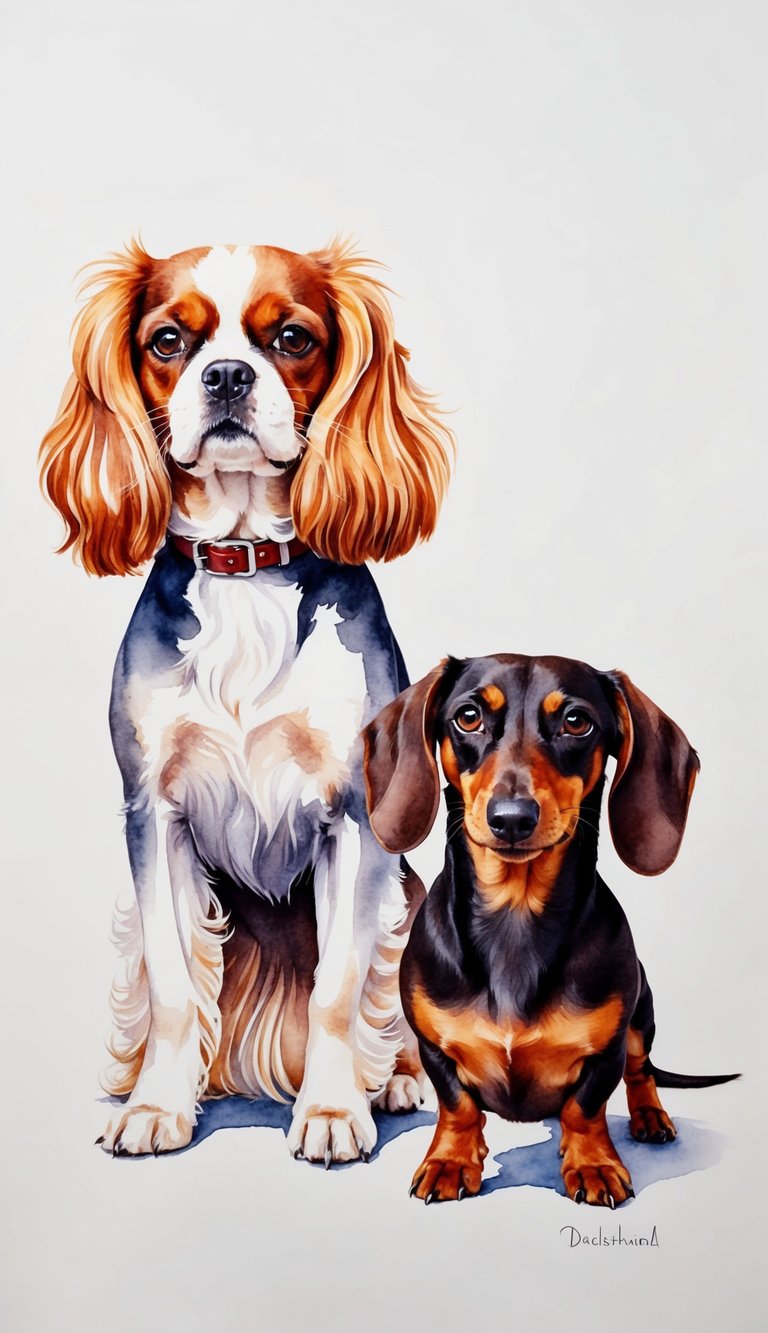
Research into Cavalier King Charles Spaniels and Dachshunds digs into the genes, health concerns, and breed history that might sway your decision. Universities and researchers have played a big part in figuring out what really sets these breeds apart.
Scientific Insights and Discoveries
Cavalier King Charles Spaniels seem to get the short end of the stick when it comes to genetic health. Years of strict breeding have left them with more harmful genetic variants than most dogs.
That means Cavaliers face higher risks for heart issues and some neurological diseases, according to scientific reports. Dachshunds, on the other hand, are famous for back problems, especially intervertebral disc disease.
Their long backs and short legs make them injury-prone. Genetic research points to specific mutations tied to bone growth as the main culprit.
Dachshunds often deal with mobility problems as they age.
Notable Institutions and Researchers
Top universities and respected scientists have really zoomed in on these breeds. Researchers from Uppsala University—Erik Axelsson comes to mind—have done a lot on genetic differences in dog breeds.
Axelsson’s work in PLOS Genetics stands out for showing how intense breeding shapes breed health, especially for Cavaliers. Other research teams team up with veterinary hospitals and international genetics labs.
Their findings help us understand what health risks and needs are unique to each breed. Uppsala University keeps leading the way, and breeders and vets use their research to make decisions for both Cavaliers and Dachshunds.
Training and Socialization
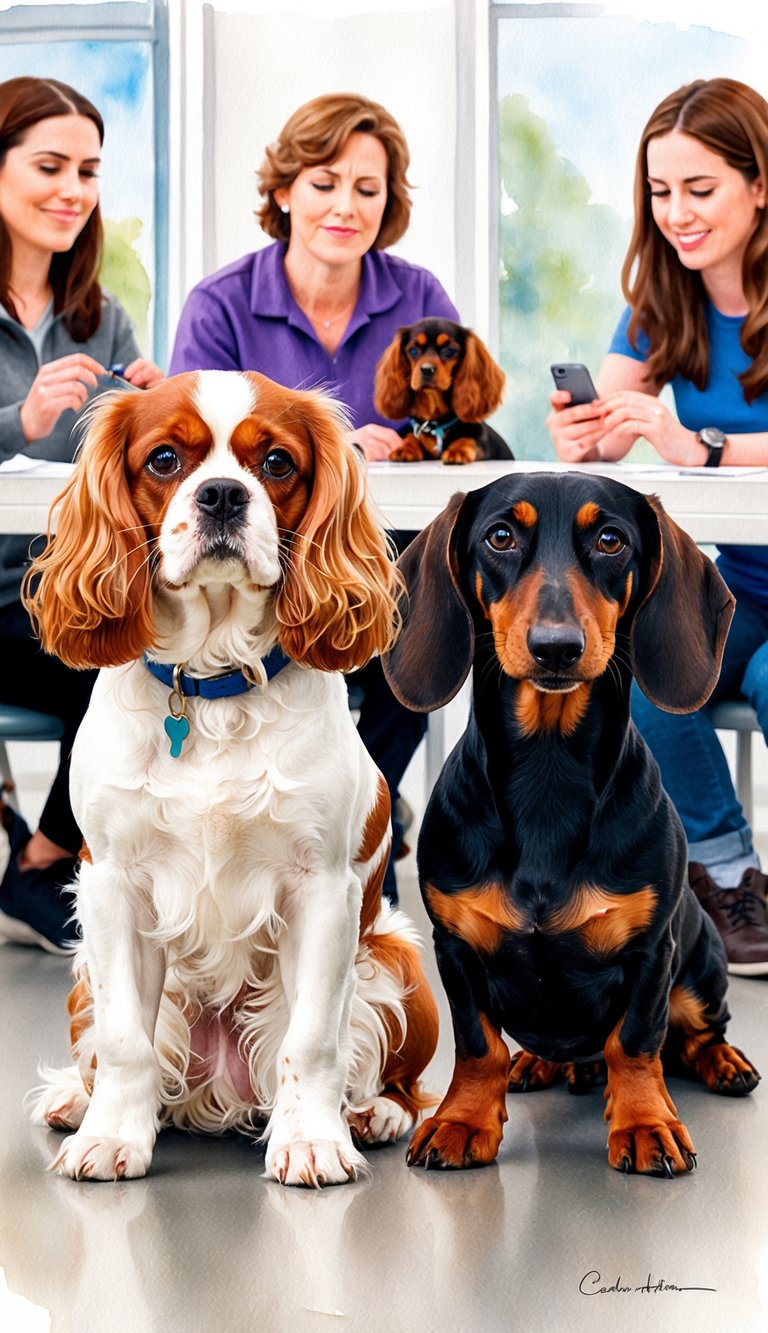
Cavalier King Charles Spaniels and Dachshunds have distinct personalities when it’s time to learn new things or handle new situations. Early training and solid socialization matter for both if you want a well-behaved adult dog.
Puppy Training Approaches
Cavalier King Charles Spaniels really want to please you and respond best to positive reinforcement. Treats, praise, and play go a long way when teaching commands or manners.
They’re sensitive souls—gentle corrections work better than harsh discipline. Short, regular training sessions keep Cavaliers engaged and help avoid boredom.
Dachshunds are clever but can be a bit stubborn. You’ll need patience and consistency to get through to them.
They might try to do their own thing, so it’s important to set boundaries without being harsh. Treats and praise help, but keep sessions short—Dachshunds lose interest fast.
Early socialization with people and other pets helps both breeds avoid behavioral issues later.
Key tips:
- Stick with positive reinforcement.
- Keep training short and fun.
- Start early for the best results.
Adaptation to Different Environments
Cavaliers are super adaptable. They get along with kids, other dogs, and even strangers.
This breed fits right in with city or country life, busy homes, or quieter ones. They don’t usually try to escape, so they’re safer in most environments.
Cavaliers are social to the core and need plenty of interaction. They’re happiest when included in family activities.
Dachshunds like being around people, but their hunting background makes them a bit more territorial. They might bark at new sights or sounds, especially in unfamiliar places.
Dachshunds love to dig and chase, so you’ll need secure fencing and to keep an eye on them. They do fine in apartments or houses as long as they get enough exercise and attention.
If you want to see how these breeds stack up in terms of adaptability, check this breed comparison.
Comparison with Other Popular Breeds
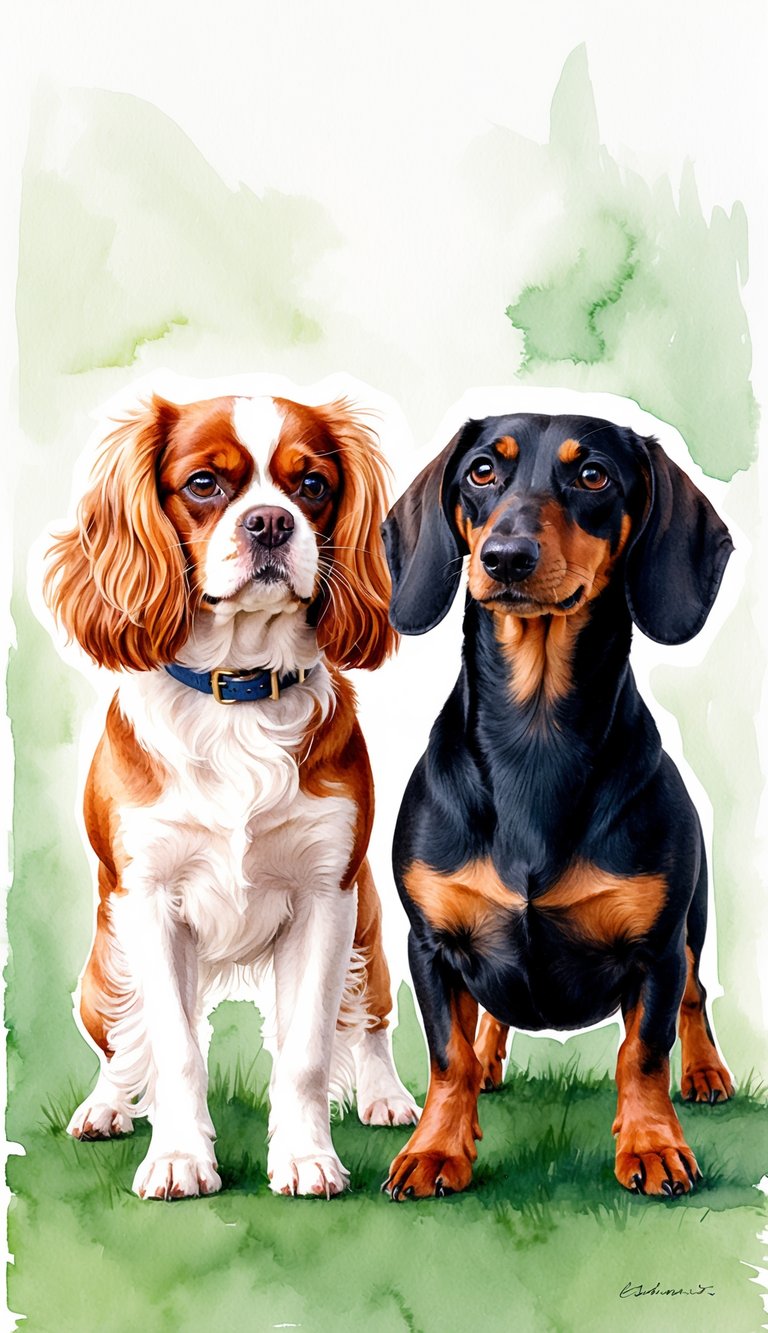
Every companion breed brings something different to the table—personality, size, energy, and care needs. If you’re picking a dog for your lifestyle, comparing their traits is a smart move.
Cavalier King Charles Spaniel and Beagle
Cavalier King Charles Spaniels are friendly, love being close to people, and are happy to snuggle on the couch. They’re small, usually 13 to 18 pounds, and their gentle vibe makes them great with both kids and adults.
They fit well in apartments and don’t need as much exercise as bigger breeds. Beagles are a little larger, topping out around 25 pounds, and are known for their keen sense of smell and adventurous spirit.
Beagles need more exercise and mental stimulation than Cavaliers. Their curiosity sometimes leads them to wander if you don’t keep them on a leash.
Beagles also tend to bark more, especially if they’re bored or alone. Both breeds are family-friendly, but Beagles can be more independent and stubborn.
| Trait | Cavalier King Charles Spaniel | Beagle |
|---|---|---|
| Average Weight | 13-18 lbs | 20-25 lbs |
| Exercise Needs | Moderate | High |
| Social with Children | Yes | Yes |
| Energy Level | Calm | Energetic |
| Ease of Training | Easy | Sometimes Stubborn |
Dachshund and German Shepherd
Dachshunds are small, long-bodied, playful, and alert. Depending on whether they’re miniature or standard, they weigh anywhere from 11 to 32 pounds.
They’re loyal but can be wary of strangers and like to bark. Dachshunds are brave for their size, but you have to handle them carefully because of back issues.
German Shepherds are much bigger—usually between 50 and 90 pounds. They’re smart, loyal, and pick up new skills fast, which makes them great working dogs and family protectors.
If you want a dog that’s protective and quick to learn, the German Shepherd stands out. Both breeds need mental stimulation, but German Shepherds need a lot more exercise and room to roam.
Socialization matters for both to avoid shyness or aggression.
Key differences:
- Size: Dachshunds are much smaller
- Protectiveness: German Shepherds win here
- Exercise: German Shepherds need way more
Other Small Companion Breeds
Looking for more options? Breeds like the Labrador Retriever, Rottweiler, and Poodle all have their perks.
Labradors aren’t small, but they’re often compared for their gentle nature and loyalty. Labs are great for active families but definitely need space and regular exercise.
Rottweilers are strong and confident. They do best with experienced owners and clear boundaries, and they’re protective but also loving with their families.
Poodles come in toy and miniature sizes. They’re smart, easy to train, and a popular pick for folks with allergies since they’re low-shedding.
Poodles fit in well with families who want a trainable, friendly pet that adapts to city or suburban life. For more breed comparisons, check out Dog Learn.
Suitability for Prospective Owners
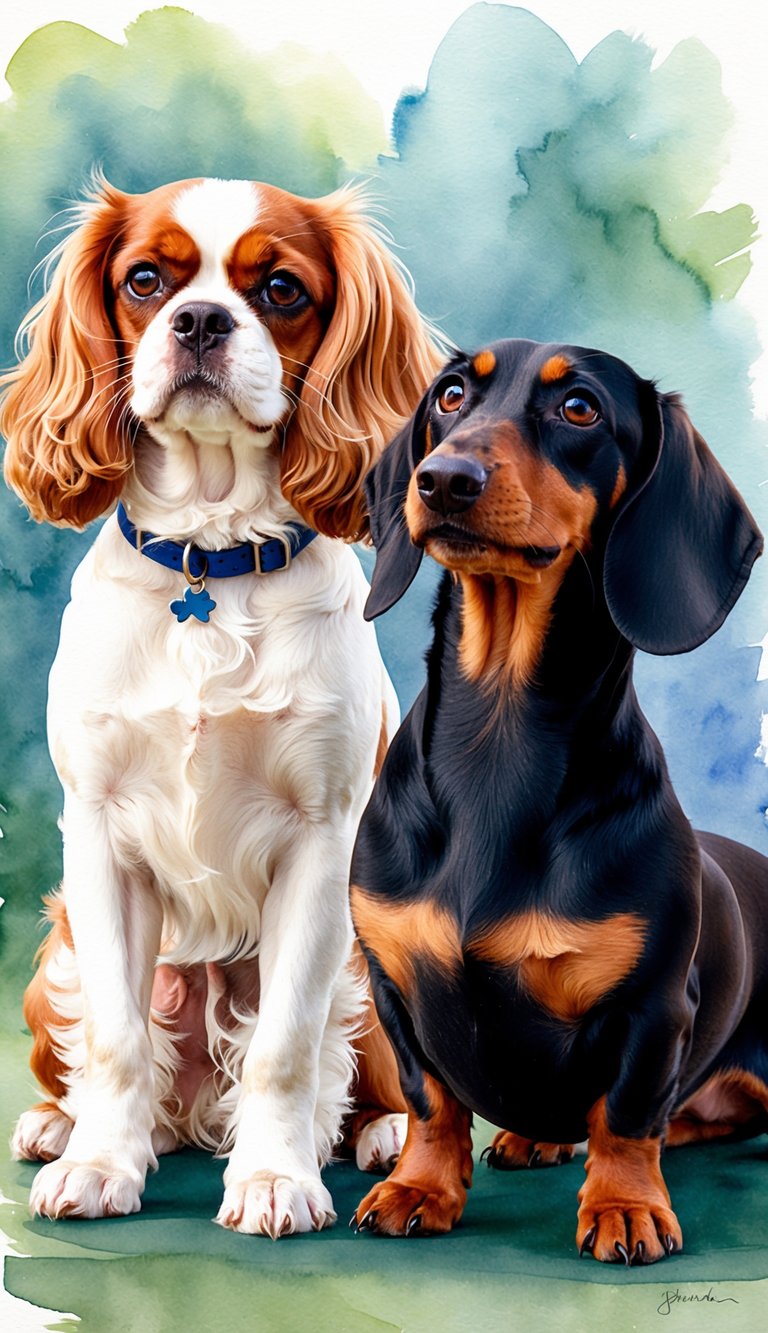
Cavalier King Charles Spaniels and Dachshunds are both popular small breeds, but they fit different types of owners and lifestyles. Differences in living needs and care routines might sway which one’s the best fit for your home.
Lifestyle Match and Living Arrangements
Cavaliers are gentle and social, happy in apartments or houses with yards. They love spending time with people and want to be part of your daily routine.
This breed adapts well if you work from home or have a family that gives them plenty of attention. Dachshunds have a bold, independent streak.
They can handle a bit more alone time than Cavaliers, but still need companionship. Their strong prey drive means they might chase small animals, so a secure yard is a must.
Both breeds enjoy short daily walks, but Dachshunds don’t need as much vigorous exercise. If you’re laid-back and want a cuddle buddy, the Cavalier could be your match.
If you’re a bit more active and like spending time outdoors (but not for hours), Dachshunds can keep up in short bursts. You’ll find more details in this breed comparison.
Requirements for Care and Maintenance
Cavalier King Charles Spaniels need regular brushing. Their long, silky coats can mat and tangle if you skip it.
They also need their ears cleaned and teeth brushed. Skipping these steps can lead to health issues.
These pups sometimes get heart or eye problems. So, regular check-ups with the vet really matter.
Dachshunds come in smooth, wire, or long-haired varieties. If you have a smooth-coated one, grooming is pretty simple.
Long-haired Dachshunds, though, need more brushing. Their coats can get messy fast.
Because of their long backs, Dachshunds often have back issues. Try to stop them from jumping off furniture, and keep an eye on their weight.
Both breeds benefit from training and positive reinforcement. Cavaliers usually want to please, while Dachshunds might be a bit more stubborn.

